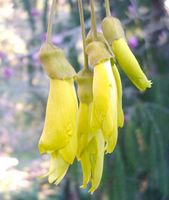
Kowhai -great mini unit.

Kowhai trees signal the beginning of spring but too often they are taken for granted.
Over the years I have seen teachers make use of the Kowhai, and the good spring weather, as a great integrated mini unit, so I thought I would share some of the ideas I have seen.
What do your students know already about the kowhai? What do kowhais mean to them? What question might they have about them?
Visit a kowhai – almost all New Zealand school has one in their grounds or nearby. At first just admire it using the senses and encouraging imaginative responses. One idea is to write a three line poem ( a simple haiku) .Ask the children for one phrase looking into the tree or flower, another about the branches, and one about the petals lying on the ground , or better still falling from the tree.
If the teacher were to collect some flowers, back in class students could be asked to draw them carefully with pencil and then use coloured pencils. Black biros are great to use also, as are fine line ink pens. Encourage the students to look carefully and to take their time – the secret to a good piece of observation is to: ‘look- draw- look’. An important ‘message’ the students should get is that quality work takes time!
The poems and drawing can be displayed with suitable captions.
The next day students can become amateur botanists and research the plant. The teacher would need to negotiate the study questions with the students about:
the shape of the tree, the bark, the leaves, how the flowers are arranged, and if there are any pods from last year.
Often tui birds will also be found feeding on the trees; research about these birds and what they are feeding on. Tuis make great subjects to draw (best from a suitable photo) and kowhais can be used for the background.
Using the flowers collected previously children can carefully pull them apart to see how many petals there are and what other parts can be seen. Using reference book these parts can be named and counted. Pods from last year can be collected and graphs can be made of how many seeds in a pod, introducing percentages.
Return to the tree and tie a piece of wool on several flowers to watch how quickly the female stigma grow into pods. They grow quickly, thin and long at first, and this growth can be measured and also graphed.
Reference books can be used to gather more information if required. Look for other plants with pods and similar flowers ( peas, beans, broom, gorse) - some students may begin to understand the 'big idea' that quite different plants are classified by their flower structure.
All this material can be placed in student’s topic book, or maths books, or on the wall.
This could be all over in week and the skills developed can be used in future situations.
2 comments:
Great ideas
Thanks for visit.
Post a Comment